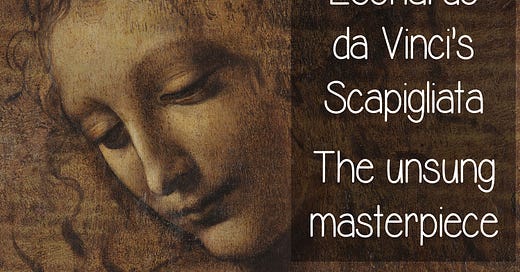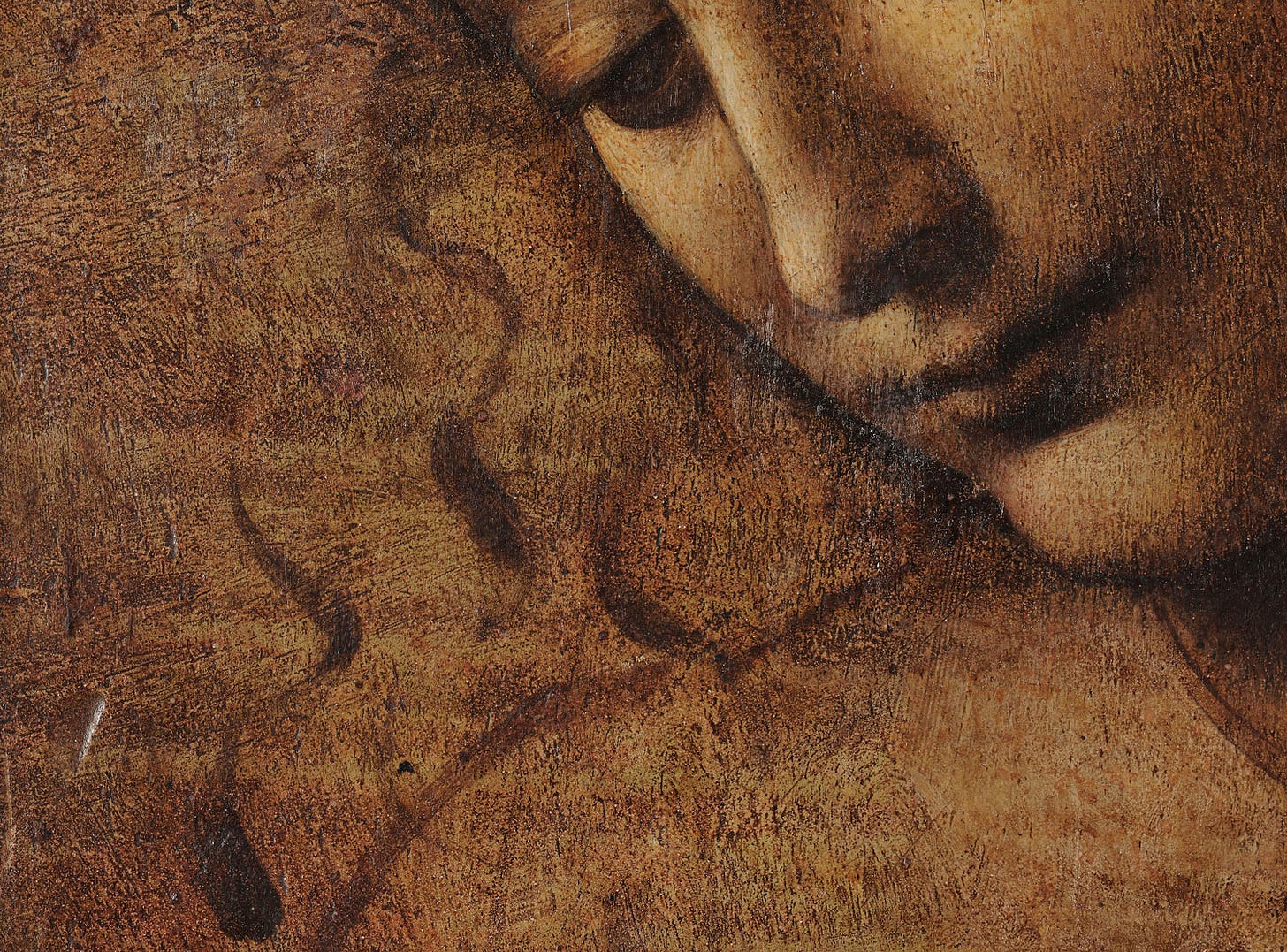After the tale of a Leonardo da Vinci painting used as a stool, the story of another wooden panel that somehow survived.
Remember that there are only about fifteen Leonardo paintings.
Even for another 'slow painter,' Vermeer, we have twice as many, as there are 34 known Vermeers—that will be another story—.
For context, let us first discuss a famous masterpiece that no one sees.
An unseen masterpiece, the Mona Lisa
The number one complaint about the Mona Lisa is that it is small.
It is not; it is precisely what one should expect, a portrait, about lifesize, of a lady seated on a chair. She smiles, and that is it.
On average, 20,000 people queue up daily in front of the Mona Lisa to take a photo no one will look at.
Most visitors are disappointed by the experience of waiting to see a masterpiece from thirty feet away for a quick glance behind a small screen.
One of the most important paintings of the Renaissance failed to leave its mark.
It is impossible to get up close due to the crowds, the distance, and the bulletproof glass.
Hence, seeing the Mona Lisa is no longer achievable.
Today, it has officially been announced that the Mona Lisa will be moved to her own room.
It remains an astonishing portrait; so important that Vasari, who wrote a book about the Lives of Artists, dedicated an entire page to it.
Amazingly, he had never seen it! But he interviewed people who did, and they were so astonished by what they saw that he was able to write:
The mouth, with its opening joining the red of the lips to the flesh of the face, seemed to be real flesh rather than paint.
Anyone who looked very attentively at the hollow of her throat would see her pulse beating.
To tell the truth, it can be said that portrait was painted in a way that would cause every brave artist to tremble and fear, whoever he might be.
Here, we discuss a small portrait by Leonardo da Vinci.
An unsung Leonardo masterpiece
It was one of these lost wooden panels, unfinished—and always unsigned—that Leonardo left behind.
It only appeared in 1839, described as:
A little Leonardo da Vinci, an extremely rare thing to find in our day.
It owes its name, La Scapigliata, Italian for "disheveled lady," to a 1625 inventory that states:
A painting depicting the head of a woman with disheveled hair, a sketch framed in violin wood, the work of Leonardo da Vinci.
Seeing a Leonardo masterpiece for the first time
Before describing La Scapigliata further, confession time: even as an admirer of Leonardo, I had never seen it.
The Scapigliata is held in a museum in Parma, a city between Milan and Florence. Although I visited the other two, I never found the time to go there.
So, I had only seen it in book reproductions.
In 2019, to commemorate the 500th anniversary of Leonardo's death, the Louvre organized an exhibition that was one of the best I have ever seen.
Most of Leonardo's masterpieces, paintings, sketches, and notebooks were there.
I visited the exhibition as soon as it opened and was so overwhelmed that I went back immediately for a second visit.
First seeing Leonardo's sketches after years of wait
One of the reasons I was blown away is the drapery studies.
They are very rarely displayed because they are fragile and sensitive to light.
However, to art historians, they are as famous as the Mona Lisa is to the general public.
But I had never actually seen the real thing.
And here were ten in one place. Apologies to the cleaning staff for the pools of drool I left behind.
The sketches were at the beginning of the exhibition when most visitors pay attention to every little detail.
But curators always keep the cherries of the cake at the end of the exhibition.
By then, most visitors are exhausted, pay a cursory glance at the masterpieces in the last room, and leave—big mistake.
There was a small portrait—about an A4 piece of paper—, La Scapigliata.
La Scapigliata
If you look at it quickly, it looks like a strange brown sketch. But it is not a sketch on paper; but a painting.
Getting up close, one realizes that the face is softly built up using brown and white.
The next surprising thing is the contrast between how finished the face is and how unfinished the head and hair are, quickly done with a few brushstrokes.
If you ask, ‘What is this small painting?’ the answer is that we do not know. Why, whom, where, when, nothing.
Once said, here is an educated guess at what we are looking at now.
A painter's painting
Even the great Leonardo lived in an age when painters were craftsmen paid to create images for churches or palaces.
They were not supposed to paint for pleasure. Sketch studies were usually related to a work commissioned by a church or politician.
Yet this is not a study on paper but a painting—in other words, it is probably the finished result.
A painting meant for an audience of one, Leonardo himself.
Or, maybe, a conversation between two painters, Leonardo and Apelles, one of the greatest painters of Antiquity.
Leonardo's silent conversation with Apelles
Yes, you probably never heard of Apelles, even less seen one of his works.
It is not surprising, as the number of original masterpieces by the most influential Greek artists of Antiquity that exist today is somewhere between almost none and zero.
But these artists were so influential that their memory lingered on.
The handwritten note above is important because it clearly states
The painter Apelles.
In this way Leonardo da Vinci makes it in all his paintings, for example the head of Lisa del Giocondo ...
It does prove that Mona Lisa is Lisa del Giocondo, but for us today, the critical part is the comparison with Apelles:
Apelles perfected the head and bust of his Venus with the most elaborate art, but left the rest of her body in the rough.
Understand 'rough' as unfinished.
Do you start to see the relation with the strong contrast between the finished and unfinished aspects of La Scapigliata?
It could be an attempt by Leonardo to compete with a master from Antiquity.
Leonardo's gracefulness
Beyond educated guesses, let us read what the master himself wrote in his advice to artists about painting heads:
Therefore make the hair on the heads play in the wind around youthful faces and gracefully adorn them with many cascades of curls.
And look again at La Scapigliata's ‘cascade of curls’ and her graceful face.
The simple but powerful act of seeing a painting
Let us conclude with Leonardo's own words:
The eye, which is said to be the window of the soul, is the primary means by which the common sense of the brain may fully and magnificently contemplate the infinite works of nature.
By 'common sense,' understand ‘five senses,’ all linked to the mind.
Now, do you not see that the eye embraces the beauty of all the world?
If you say that sciences are not mechanical but cerebral, I say to you that painting is cerebral.
Seeing a Leonardo painting is a chance to look at the beauty of the world inside one's mind.
That was what happened with La Scapigliata, which I looked at intensely each time I got a chance.
And that was a very big Moment of Wonder.
Notes
https://artjourneyparis.com/blog/mona-lisa-story-behind-fame.html
https://complessopilotta.it/en/opera/testa-di-fanciulla-detta-la-scapiliata-en/
https://books.google.fr/books?id=roHf588GZJYC&printsec=frontcover&hl=fr#v=onepage&q&f=false
https://digi.ub.uni-heidelberg.de/diglit/cicero1477/0023/image,info#col_thumbs
https://collections.louvre.fr/ark:/53355/cl010062370
https://collections.louvre.fr/ark:/53355/cl020003018
https://www.nytimes.com/2025/01/28/arts/design/mona-lisa-louvre-macron.html
https://www.theartnewspaper.com/2025/01/28/emmanuel-macron-musee-louvre-renovations-expansion












I love this post. Guillaume ends this daily wonder with “Seeing a Leonardo painting is a chance to look at the beauty of the world inside one's mind.”
By the end of the article, you have come to know what that means. Thank you for this wonderful read.